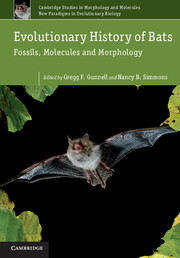Book contents
- Frontmatter
- Contents
- Contributors
- Preface
- 1 Phylogenies, fossils and functional genes: the evolution of echolocation in bats
- 2 Systematics and paleobiogeography of early bats
- 3 Shoulder joint and inner ear of Tachypteron franzeni, an emballonurid bat from the Middle Eocene of Messel
- 4 Evolutionary history of the Neotropical Chiroptera: the fossil record
- 5 New basal noctilionoid bats (Mammalia: Chiroptera) from the Oligocene of subtropical North America
- 6 Necromantis Weithofer, 1887, large carnivorous Middle and Late Eocene bats from the French Quercy Phosphorites: new data and unresolved relationships
- 7 African Vespertilionoidea (Chiroptera) and the antiquity of Myotinae
- 8 Evolutionary and ecological correlates of population genetic structure in bats
- 9 A bird? A plane? No, it's a bat: an introduction to the biomechanics of bat flight
- 10 Toward an integrative theory on the origin of bat flight
- 11 Molecular time scale of diversification of feeding strategy and morphology in New World Leaf-Nosed Bats (Phyllostomidae): a phylogenetic perspective
- 12 Why tribosphenic? On variation and constraint in developmental dynamics of chiropteran molars*
- 13 Necromantodonty, the primitive condition of lower molars among bats
- 14 Echolocation, evo-devo and the evolution of bat crania
- 15 Vertebral fusion in bats: phylogenetic patterns and functional relationships
- 16 Early evolution of body size in bats
- Index
- Plate section
- References
4 - Evolutionary history of the Neotropical Chiroptera: the fossil record
Published online by Cambridge University Press: 05 June 2012
- Frontmatter
- Contents
- Contributors
- Preface
- 1 Phylogenies, fossils and functional genes: the evolution of echolocation in bats
- 2 Systematics and paleobiogeography of early bats
- 3 Shoulder joint and inner ear of Tachypteron franzeni, an emballonurid bat from the Middle Eocene of Messel
- 4 Evolutionary history of the Neotropical Chiroptera: the fossil record
- 5 New basal noctilionoid bats (Mammalia: Chiroptera) from the Oligocene of subtropical North America
- 6 Necromantis Weithofer, 1887, large carnivorous Middle and Late Eocene bats from the French Quercy Phosphorites: new data and unresolved relationships
- 7 African Vespertilionoidea (Chiroptera) and the antiquity of Myotinae
- 8 Evolutionary and ecological correlates of population genetic structure in bats
- 9 A bird? A plane? No, it's a bat: an introduction to the biomechanics of bat flight
- 10 Toward an integrative theory on the origin of bat flight
- 11 Molecular time scale of diversification of feeding strategy and morphology in New World Leaf-Nosed Bats (Phyllostomidae): a phylogenetic perspective
- 12 Why tribosphenic? On variation and constraint in developmental dynamics of chiropteran molars*
- 13 Necromantodonty, the primitive condition of lower molars among bats
- 14 Echolocation, evo-devo and the evolution of bat crania
- 15 Vertebral fusion in bats: phylogenetic patterns and functional relationships
- 16 Early evolution of body size in bats
- Index
- Plate section
- References
Summary
Introduction
Recent improvements in the fossil record of bats in the Americas provide new raw material to bolster interpretations of bat evolution and paleobiogeography. Herein we review the fossil record of bats from North America and South America and provide a narrative explanation of the historical development of the Neotropical bat fauna from a paleontological and biogeographical perspective. The phylogeography of bats in the Western Hemisphere as it pertains to the development of the modern Neotropical biogeographic region may also be important in developing strategies for the conservation of the tropical American chiropteran fauna.
Throughout most of the Cenozoic Era there were three widely separated tropical regions in the New World: the island continent of South America, excluding temperate latitudes in Argentina and Chile; the West Indies and Middle America, including Central America and central and southern Mexico, and at times extending northward to encompass the Gulf Coastal Plain from Texas east to Florida. North America and South America possessed very different mammalian faunas prior to the Great American Biotic Interchange, which began with a limited exchange of large non-volant mammals in the Late Miocene (~9 Ma), presumably by overwater dispersal, and then became a fully fledged interchange following the formation of the Panamanian Isthmus joining these two continents in the Early Pliocene (~5 Ma). From the Pliocene onward, there was extensive intermingling between North and South American biotas, and the tropical portions of these two continents now share a common Neotropical mammalian fauna that extends northward to about the Tropic of Cancer (~23°N latitude) in central Mexico and southward to about the Tropic of Capricorn (~23°S latitude) in southern Brazil, Paraguay and northern Argentina. The tropical American bat fauna has become so extensively intermixed since the Interchange, particularly in Middle America, that it is very difficult to determine the origin of most groups that lack a fossil record. By studying pre-Pliocene bats we can establish the pre-Interchange chiropteran faunas of North and South America, thereby determining which groups of bats were involved in the Interchange and where they may have originated. The Tertiary record of New World bats is primarily limited to temperate North America and tropical South America, with two localities from Patagonia in temperate South America. The Middle American Tertiary chiropteran record is limited to the extinct vespertilionid genus †Plionycteris from two Early Pliocene sites in Mexico (Lindsay and Jacobs, 1985; Carranza-Castañeda and Walton, 1992).
- Type
- Chapter
- Information
- Evolutionary History of BatsFossils, Molecules and Morphology, pp. 105 - 161Publisher: Cambridge University PressPrint publication year: 2012
References
- 19
- Cited by



